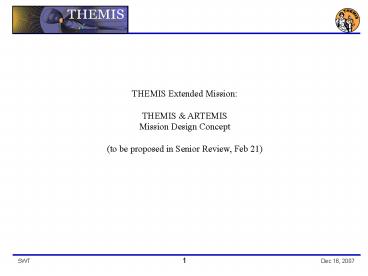THEMIS Extended Mission: - PowerPoint PPT Presentation
1 / 21
Title:
THEMIS Extended Mission:
Description:
String-of-Pearls. Variable along-track. separations: 100km-2RE. SWT 4 ... Un-optimized string-of-pearls, but sufficient to build experience in clustering probes ... – PowerPoint PPT presentation
Number of Views:53
Avg rating:3.0/5.0
Title: THEMIS Extended Mission:
1
THEMIS Extended Mission THEMIS
ARTEMIS Mission Design Concept (to be proposed
in Senior Review, Feb 21)
2
P3,4,5, orbits for T3/D3/R3Separations gt0.5RE in
dR-dZ
Y
R3 (Year-round)
X
Z
P5
P3
P4
R3, GSE coords View from topdZ(P3-P5), as in
T3.Variable along-trackseparations
3
P3,4,5 orbits for T4, D4, R4, T5Separations lt
0.5RE in dR-dZ
T4 (2011-05-10)T5 (2012-06-21)
D4 (2011-12-01)
Z
Z
1000km
Y
Y
X
T4 (and T5), GSE coords View from dawn along
NS dZ(P3-P5) 100-500km dR(P3-P4)1000km gt
dZ every day Apogee 12RE
X
D4, GSE coords dZ(P3-P5) 1000-3000kmdR(P3-P4)
1000km lt dZevery day Apogee12Re
R4 (at Dawn/dusk)
P5
P4
P3
R4, GSE coords View from topString-of-Pearls.V
ariable along-trackseparations 100km-2RE
4
P3,4,5 prime maneuvers and deltaV
5
Maneuvers/Operations THEMIS
- P3,4,5 have been maneuvered to close proximity
before (coast-phase experience) - Un-optimized string-of-pearls, but sufficient to
build experience in clustering probes - Orbits are stable and shadows benign
- Operations are anticipated to be standard, but
could get numerous (trimming) - Maneuver planning is rather complex (as complex
as THEMIS prime) - Contacted MMS and Cluster teams (Hughes/GSFC,
Detlef Sieg/ESA) - Careful orbit design to ensure science benefits
is required and will start early - Triangle (THEMIS) is easier than tetrahedron
(Cluster) but orientation and scales are critical - Like for the THEMIS prime mission, we need to
make careful science, deltaV and operational
complexity trades to obtain a balance between
science and available resources - The THEMIS P3,4,5 extended mission design builds
on tremendous heritage in maneuver and orbit
reconstruction operations and is expected to not
necessitate additional operational tools except
for additional science orbit optimization to
ensure a balance between science and resources .
6
Maneuvers/Operations ARTEMIS
- P1, P2 have sufficient fuel to raise apogee to
the moon - Easier to go up than down
- Lunar gravity perturbs orbits sufficiently to
remove long shadows - Probes need not stay any longer in Earth orbit
- Mission design and operations can become complex
and expensive unless new target is found - Use the moon as anchor to perform new tail and
new Solar Wind science - Permits exploration of a unique Lunar-Solar and
Lunar-Tail environment like never done before - Optimal use of de-orbit fuel (lunar re-entry)
- Design considerations for Lunar insertion, result
in a robust mission - Spin axis at ecliptic normal throughout mission
optimal communications - Equatorial Lunar orbit stable for many years
- After Lunar Orbit Insertion operations are
routine - A 24hr orbit guarantees
- Less than 3.5hr shadows, acceptable for probe
design - Familiar, low risk power, thermal and operations
environment - Mission design that satisfies above criteria is
robust - Under study by JPL since April 2005
- By same team which validated the THEMIS mission
design in 2004-2005 - JPL review on 2007-Nov-02 found no technical
issues
7
ARTEMIS Acceleration, Reconnection, Turbulence
and Electrodynamics of the Moons Interaction
with the Sun
8
ARTEMIS Selective Orbits
Phase I (Oct 09 Oct 10) - placement
9
ARTEMIS Selective Orbits
Phase II (Oct 10 Jan 11) opposite
10
ARTEMIS Selective Orbits
Phase II (Oct 10 Jan 11) opposite
11
ARTEMIS Selective Orbits
Phase III (Jan 11 Apr 11) same side
12
Phase III (Jan 11 Apr 11) same side
13
Phase III (Jan 11 Apr 11) same side
14
ARTEMIS Wake Crossings Phase II,III
15
ARTEMIS Distant Wake CrossingsA Perspective
dB
16
Phase IV (Apr 11 Sep 12) ARTEMIS After
Insertion
17
ARTEMIS Wake Crossings
18
ARTEMIS Mission Profile
19
Trajectory Characteristics
- There are 2 spacecraft (P1 and P2) that need to
go from Earth orbit to Lunar Lissajous orbits to
Lunar orbit. - Limited total ?V available (P1 300.0 m/s, P2
448.5 m/s) - A low-energy trajectory is used for the
Trans-lunar trajectory leg. - Spacecraft will be in orbit around opposing
Lagrange points for 3 months. - Spacecraft will be in orbit around the same
Lagrange point for 2 months. - Models and Assumptions
- Planetary bodies
- Point Bodies Sun and Moon
- Earth Including J2
- Deterministic, impulsive maneuvers
20
Fuel summary P1,P2
P1
Total DV 205.22 m/s
P2
Total DV 297.19 m/s
21
Fuel from inefficiencies P1,P2
Grand TotalP1 257m/s (have 300m/s)P2 363m/s
(have 450m/s)

